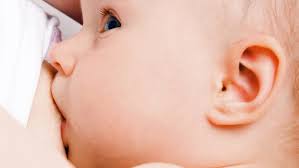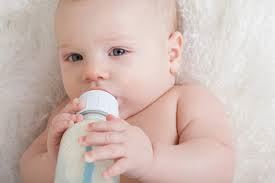Breastfeeding is the act of giving human milk to an infant. The mother, after she has given birth, has colostrum built up in her breast for the newborn to drink. Colostrum acts as a natural laxative for the baby because it so high in protein and low in fat and sugar. The colostrum contains important immunities the baby needs to protect their fragile immune system (Sutter Health, n.d.).
After 48 to 72 hours the milk changes to mature milk. Foremilk, which is thin and watery with a light blue tinge, is produced first. This milk helps to satisfy the baby’s thirst. After several minutes of feeding the hind-milk comes in which is higher in fat and helps satisfy the baby’s hunger. The baby should be fed until they look sleepy and satisfied. This process will continue every two to three hours until the baby is old enough to eat table food; this is usually around six months of age (Sutter Health, n.d.).
Bottle feeding is the act of giving an infant formula from a bottle. There are several different brands of formula on the market today so it is hard to distinguish which is best for the new born. If the newborn shows any signs of allergy to one type of formula it will be necessary to change brands. Once the proper brand is found the parents can continue to feed their child from a bottle every three to four hours as needed.
Bottle feeding can be done by either parent or another caregiver. The person feeding the child must sit up and cradle the baby to avoid too much air being swallowed. It is also necessary for the caregiver to burp the baby after every few ounces to ensure the baby will not spit up the milk. After feedings, the formula, if not completely used, should be refrigerated or thrown out.
Benefits of Breastfeeding
 There are many benefits to breastfeeding for both the mother and the baby. Some of the benefits that the baby receives are good nutrition and easy digestion. Breast milk is known as the perfect food for baby’s digestive system because it contains lactose, protein, and fat. Breast milk naturally contains the total daily amount of vitamins and minerals required for their growing bodies. Breastfeeding also helps prevent childhood and adult obesity because the baby gains less unnecessary weight (Nemours Foundation, 2008).
There are many benefits to breastfeeding for both the mother and the baby. Some of the benefits that the baby receives are good nutrition and easy digestion. Breast milk is known as the perfect food for baby’s digestive system because it contains lactose, protein, and fat. Breast milk naturally contains the total daily amount of vitamins and minerals required for their growing bodies. Breastfeeding also helps prevent childhood and adult obesity because the baby gains less unnecessary weight (Nemours Foundation, 2008).
Benefits for the mother include a faster weight loss, cancer prevention, and a closer bond with their child. Mothers who breastfeed their babies exclusively can burn up to 500 calories in one day. When combined with exercise and healthy eating the mother can lose weight faster and keep it off longer. Breastfeeding has also been linked to the prevention of breast cancer and ovarian cancers (Nemours Foundation, 2008).
Today, our government is doing several things to encourage mothers to breastfeed their babies. According to CDC (n.d., pg. 46) “Both federal and state laws have been enacted that specifically allow women to breastfeed in any place they are otherwise legally allowed to be.” Many organizations and businesses have set up rooms for mothers to pump their milk or feed their child while they are in public. Even in schools they are trying to show breastfeeding as a positive imagine encouraging people from every walk of life to accept breastfeeding and even try it with their own children.
Negative Outcomes of Breastfeeding
Breastfeeding, being a positive encounter for mother and child, has its problems too. First time mothers may have problems with positioning the infant correctly or the infant may not latch on correctly and this could cause the nipples to be sore. Breast engorgement is also a problem which is the swelling of the breasts from new milk. Engorgement usually happens when the mature milk takes place of the colostrum. Engorgement can also happen when the mother does not nurse on a regular basis.
Leaking breast or let-down reflex could be a problem empirically when away from home. A mother could hear someone else’s baby cry and it would cause her milk to leak. The mother could just think of her infant and this would cause her milk to leak. The last problem is keeping up with the milk supply or wondering if the baby is getting enough milk. A big concern for most new mothers is if their baby is getting enough to eat. This uncertainty can give mothers anxiety and stress that is unnecessary.
Benefits of Bottle Feeding
 Research has shown that bottle-fed babies need to be fed less often than breast-fed babies because the milk is not easy to digest. There is no guessing with bottle feeding because the formula can be measured. A mother can let the father bottle feed if needed or another caregiver so she has time to work and do other things. These are just some of the advantages of bottle feeding.
Research has shown that bottle-fed babies need to be fed less often than breast-fed babies because the milk is not easy to digest. There is no guessing with bottle feeding because the formula can be measured. A mother can let the father bottle feed if needed or another caregiver so she has time to work and do other things. These are just some of the advantages of bottle feeding.
As far as dressing in normal clothes, a mother that bottle feeds can wear what she wants but a nursing mother has to wear certain things to make it easy for the baby to be fed. A mother who nurses has to be careful about the types of medications she uses because the medicine could be passed through the breast milk. Nutrition, while important to all mothers, does not have to be watched or monitored as closely as a breastfeeding mother; even taking an aspirin could affect the breast milk in some way.
Although drinking should be done in moderation, a bottle feeding mother can have a drink and not worry about the affect it will have on the baby through bottle feeding. Bottle feeding causes no embarrassment in public because it can be done anywhere unlike breast feeding. Dieting for a mother who chooses to bottle feed can begin in six weeks after the birth of the baby. Bottle feeding can make love making easier for a mother because her nipples are not as sore or leaking.
Negative Outcomes of Bottle Feeding
Research shows that there is a strong correlation between bottle-fed babies and a higher risk of neurological dysfunction, diarrhea, middle ear infections, and respiratory infections. There are several other challenges that a mother may want to consider when she chooses to bottle feed her baby. One challenge is organization and preparation. There should always be enough formula available to accommodate the hungry baby. The formula must be primed with sterile water. The sterile water needs to be boiled until the baby is a little over six months.
A second challenge that mothers have to face is ensuring that the baby has the important antibodies in the formula that is usually only found in breast milk. This means bottle feeding does not to give the baby enough added protection against infection and illness that breast milk does. A third challenge that a mother may face when choosing bottle feeding is formula can be very expensive; the lease expensive is the powdered formula. The closest to the least expensive is the concentrated, followed by the ready-to-feed already made up bottles being the most expensive. The specialty formulas that may be hypoallergenic or do not contain soy cost a little more. During the first year of life, the cost of basic formula can run about $1,500.
A fourth challenge that a mother may face when choosing bottle feeding is the risk of producing gas and constipation. Research shows that formula-fed babies have more gas and firmer bowel movements than breastfed babies. This can be extremely uncomfortable to the baby. Another challenge that many, if not most, bottle feeding mothers face is not being able to match the complexity of breast milk. Major formula companies have not yet been able to copy the complex nutrients of breast milk because breast milk changes as the baby’s needs change.
Conclusion
When new parents decide how they want to feed their infant they must consider all the pros and cons of breastfeeding and bottle feeding. It is important to research both topics so an informed decision can be made. Today the government is doing more to help promote breastfeeding because they have found breast is best for baby. Although this is the case, many new mothers are either unable to commit to the task because of work, school, or other issues so formula companies have done their own research to find the best substitutes for mother’s milk.
Reference:
CDC. (n.d.). Public Acceptance. Retrieved February 26, 2008, from http://www.cdc.gov/breastfeeding/pdf/BF_guide_9.pdf
Nemours Foundation. (2008). Breastfeeding vs. Formula Feeding. Retrieved February 26, 2008, from http://kidshealth.org/parent/growth/feeding/breast_bottle_feeding.html
Sutter Health. (n.d.). Breastfeeding: Breast Milk Production. Retrieved February 26, 2008, from http://www.babies.sutterhealth.org/breastfeeding/bf_production.html

